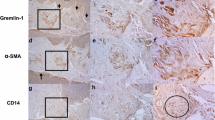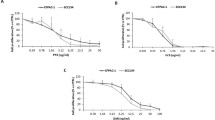Abstract
Squamous cell carcinoma (SCC) is the most major malignant tumor of the tongue. The tongue exists at the air–liquid interface and is covered with saliva. In addition, the tongue constituent cells and tongue cancer are present under fluid flow stimulation due to the abundant capillary network and contraction of muscle tissue. Therefore, replicating both cell–cell interactions (the cellular microenvironment) and the aforementioned physical microenvironment is very important for understanding the kinetics of tongue SCC. To elucidate the effects of the cellular and physical microenvironment on tongue SCC and to investigate the relationships between these factors, we developed a collagen cell disc, with double dish under a rotational culture method to generate cancer–stroma interactions and to create fluid flow stimulation. Mesenchymal cells, NIH-3T3 cells and tongue-derived fibroblasts influenced the proliferative potential. Extracellular signal-regulated kinase and p38 signaling were regulated either synergistically or independently by cellular interactions and fluid flow stimulation, depending on the SCC cell type. The cell–cell interactions and fluid flow stimulation independently, synergistically or contradictorily affected the behavior of tongue SCC. Fluid flow stimulation synergistically enhanced the antiproliferative effect of cis-diamminedichloroplatinum on tongue SCC cells, but mesenchymal cells abolished the synergistic antiproliferative effect related to fluid flow stimulation. In conclusion, a reconstructed model was established to investigate the cellular and physical microenvironments of tongue SCC in vitro. The newly established system is a promising model for the development of further regimes to treat general oral cancer.







Similar content being viewed by others
Data availability
The data that support the findings of this study are available from the corresponding authors, SA upon reasonable request.
References
Hinshaw DC, Shevde LA. The tumor microenvironment innately modulates cancer progression. Can Res. 2019;79:4557–66.
Mbeunkui F, Johann DJ. Cancer and the tumor microenvironment: a review of an essential relationship. Cancer Chemother Pharmacol. 2009;63:571–82.
Neville BW, Day TA. Oral cancer and precancerous lesions. CA Cancer J Clin. 2002;52:195–215.
Das BR, Nagpal JK. Understanding the biology of oral cancer. Med Sci Monitor Int Med J Exp Clin Res. 2002;8:RA258-267.
Mescher AL. Junqueira’s basic histology. New York: Mc Graw Hill; 2016.
Sahai E, Astsaturov I, Cukierman E, DeNardo DG, Egeblad M, Evans RM, Fearon D, Greten FR, Hingorani SR, Hunter T. A framework for advancing our understanding of cancer-associated fibroblasts. Nat Rev Cancer. 2020;20:174–86.
Liu T, Zhou L, Li D, Andl T, Zhang Y. Cancer-associated fibroblasts build and secure the tumor microenvironment. Front Cell Dev Biol. 2019;7:60.
Erdogan B, Webb DJ. Cancer-associated fibroblasts modulate growth factor signaling and extracellular matrix remodeling to regulate tumor metastasis. Biochem Soc Trans. 2017;45:229–36.
Dourado MR, Korvala J, Åström P, De Oliveira CE, Cervigne NK, Mofatto LS, Campanella Bastos D, Pereira Messetti AC, Graner E, Paes Leme AF. Extracellular vesicles derived from cancer-associated fibroblasts induce the migration and invasion of oral squamous cell carcinoma. J Extracell Vesicles. 2019;8:1578525.
Akutagawa T, Aoki S, Yamamoto-Rikitake M, Iwakiri R, Fujimoto K, Toda S. Cancer–adipose tissue interaction and fluid flow synergistically modulate cell kinetics, HER2 expression, and trastuzumab efficacy in gastric cancer. Gastric Cancer. 2018;21:946–55.
Nagase K, Akutagawa T, Rikitake-Yamamoto M, Morito S, Futamata M, Tobu S, Noguchi M, Toda S, Aoki S. Cellular and physical microenvironments regulate the aggressiveness and sunitinib chemosensitivity of clear cell renal cell carcinoma. J Pathol. 2021;254:46–56.
Aoki S, Takezawa T, Uchihashi K, Sugihara H, Toda S. Non-skin mesenchymal cell types support epidermal regeneration in a mesenchymal stem cell or myofibroblast phenotype-independent manner. Pathol Int. 2009;59:368–75.
Aoki S, Takezawa T, Sugihara H, Toda S. Progress in cell culture systems for pathological research. Pathol Int. 2016;66:554–62.
Hanashima K, Akutagawa T, Yamamoto-Rikitake M, Sakumoto T, Futamata M, Nakao Y, Yokoyama M, Toda S, Aoki S. Tissue-specific physical and biological microenvironments modulate the behavior of cervical squamous cell carcinoma. Acta Histochem Cytochem. 2021;54:155–65.
Aoki S, Makino J, Nagashima A, Takezawa T, Nomoto N, Uchihashi K, Matsunobu A, Sanai T, Sugihara H, Toda S. Fluid flow stress affects peritoneal cell kinetics: possible pathogenesis of peritoneal fibrosis. Perit Dial Int. 2011;31:466–76.
Sakuma K, Tanaka A, Mataga I. Collagen gel droplet-embedded culture drug sensitivity testing in squamous cell carcinoma cell lines derived from human oral cancers: optimal contact concentrations of cisplatin and fluorouracil. Oncol Lett. 2016;12:4643–50.
Michi Y, Morita I, Amagasa T, Murota S. Human oral squamous cell carcinoma cell lines promote angiogenesis via expression of vascular endothelial growth factor and upregulation of KDR/flk-1 expression in endothelial cells. Oral Oncol. 2000;36:81–8.
Braicu C, Buse M, Busuioc C, Drula R, Gulei D, Raduly L, Rusu A, Irimie A, Atanasov AG, Slaby O. A comprehensive review on MAPK: a promising therapeutic target in cancer. Cancers. 2019;11:1618.
Kim JB. Three-dimensional tissue culture models in cancer biology. In: Seminars in cancer biology, vol. 15. Elsevier; 2005, pp. 365–77.
Thoma CR, Zimmermann M, Agarkova I, Kelm JM, Krek W. 3D cell culture systems modeling tumor growth determinants in cancer target discovery. Adv Drug Deliv Rev. 2014;69:29–41.
Cui P, Wang S. Application of microfluidic chip technology in pharmaceutical analysis: a review. J Pharmac Anal. 2019;9:238–47.
Xu Z, Gao Y, Hao Y, Li E, Wang Y, Zhang J, Wang W, Gao Z, Wang Q. Application of a microfluidic chip-based 3D co-culture to test drug sensitivity for individualized treatment of lung cancer. Biomaterials. 2013;34:4109–17.
Verpoorte E. Microfluidic chips for clinical and forensic analysis. Electrophoresis. 2002;23:677–712.
Burotto M, Chiou VL, Lee JM, Kohn EC. The MAPK pathway across different malignancies: a new perspective. Cancer. 2014;120:3446–56.
Wagner EF, Nebreda ÁR. Signal integration by JNK and p38 MAPK pathways in cancer development. Nat Rev Cancer. 2009;9:537–49.
Lee S, Rauch J, Kolch W. Targeting MAPK signaling in cancer: mechanisms of drug resistance and sensitivity. Int J Mol Sci. 2020;21:1102.
Kim EK, Choi E-J. Compromised MAPK signaling in human diseases: an update. Arch Toxicol. 2015;89:867–82.
Guo YJ, Pan WW, Liu SB, Shen ZF, Xu Y, Hu LL. ERK/MAPK signalling pathway and tumorigenesis. Exp Ther Med. 2020;19:1997–2007.
Bulavin DV, Fornace AJ. p38 MAP kinase’s emerging role as a tumor suppressor. Adv Cancer Res. 2004;92:95–118.
Acknowledgements
We thank M. Nishida, F. Mutoh, S. Nakahara and S. Nishimura for excellent technical assistance.
Funding
This work was supported by grants from JSPS KAKENHI Grant Number 19K18468 (to MN).
Author information
Authors and Affiliations
Contributions
SI: investigation, writing—original draft. MN: investigation, methodology, writing—reviewing. MK, SM, TS: investigation. YY, ST: supervision. SA: conceptualization, methodology, investigation, writing—reviewing and editing, project administration.
Corresponding author
Ethics declarations
Conflict of interest
The authors declare that they have no conflicts of interest.
Ethical approval
All procedures involving human or animal materials were performed in accordance with the Ethical Guidelines of Saga University.
Additional information
Publisher's Note
Springer Nature remains neutral with regard to jurisdictional claims in published maps and institutional affiliations.
Supplementary Information
Below is the link to the electronic supplementary material.
13577_2023_866_MOESM1_ESM.eps
Supplementary file1 Fig. S1. Phenotypic characteristics of PFs. PFs were positive for Vimentin. αSMA-positive cells were found in 15.20 ± 3.29% of the total population. Data are presented as means ± SD of 3 determinations. PFs exhibited no positivity to CD34, S100 or CK AE1/AE3. PFs, primary fibroblasts. (EPS 1824 KB)
13577_2023_866_MOESM2_ESM.eps
Supplementary file2 Fig. S2. Effects of fluid flow and human fibroblasts on the cellular kinetics of tongue SCC. A, Representative histopathological images of SAS cells at day 10 determined by hematoxylin-eosin staining. B, Quantitative analysis of SAS cell layer thickness under each condition. On day 10, fluid flow and fibroblasts (TIG-121 cells) synergistically promoted cellular hypertrophy and thickened the SAS cell layer. C, Representative HSC-3 images determined by hematoxylin-eosin staining under each condition. On day 10, monocultured HSC-3 cells under static or fluid stimulation showed no difference in the cell layer thickness. HSC-3 cells co-cultured with TIG-121 cells exhibited an increased cell layer thickness and cell enlargement, and fluid stimulation further increased the cell layer thickness and also cell enlargement. D, Thickness of HSC-3 cell layers. All data represent means ± SD of 3 determinations. * P < 0.05. Mono, monoculture; S, static conditions; F, fluid flow stimulation (EPS 1353 KB)
13577_2023_866_MOESM3_ESM.eps
Supplementary file3 Fig. S3. Effect of fibroblasts and fluid flow on the JNK signaling pathway in tongue SCC. JNK expression levels in A, SAS or B, HSC-3 cells were evaluated by western blotting. Relative expression is depicted as the ratio of target protein expression to α/β-tubulin expression. All data represent means ± SD of 4–5 determinations. * P < 0.05. Mono, monoculture; PF, primary fibroblasts; S, static conditions; F, fluid flow stimulation. (EPS 1932 KB)
13577_2023_866_MOESM4_ESM.eps
Supplementary file4 Fig. S4. Uncropped western blot images of Fig. 4. Mono, monoculture; PF, primary fibroblasts; S, static conditions; F, fluid flow stimulation. (EPS 838 KB)
13577_2023_866_MOESM5_ESM.eps
Supplementary file5 Fig. S5. Uncropped western blot images of Fig. 7. Mono, monoculture; PFs, primary fibroblasts; S, static conditions; F, fluid flow stimulation; CDDP, cis-diamminedichloroplatinum. (EPS 2557 KB)
Rights and permissions
Springer Nature or its licensor (e.g. a society or other partner) holds exclusive rights to this article under a publishing agreement with the author(s) or other rightsholder(s); author self-archiving of the accepted manuscript version of this article is solely governed by the terms of such publishing agreement and applicable law.
About this article
Cite this article
Iwamoto, S., Nishiyama, M., Kawasaki, M. et al. Oral-specific microenvironments regulate cell behavior and anticancer drug sensitivity of tongue squamous cell carcinoma. Human Cell 36, 643–656 (2023). https://doi.org/10.1007/s13577-023-00866-x
Received:
Accepted:
Published:
Issue Date:
DOI: https://doi.org/10.1007/s13577-023-00866-x




